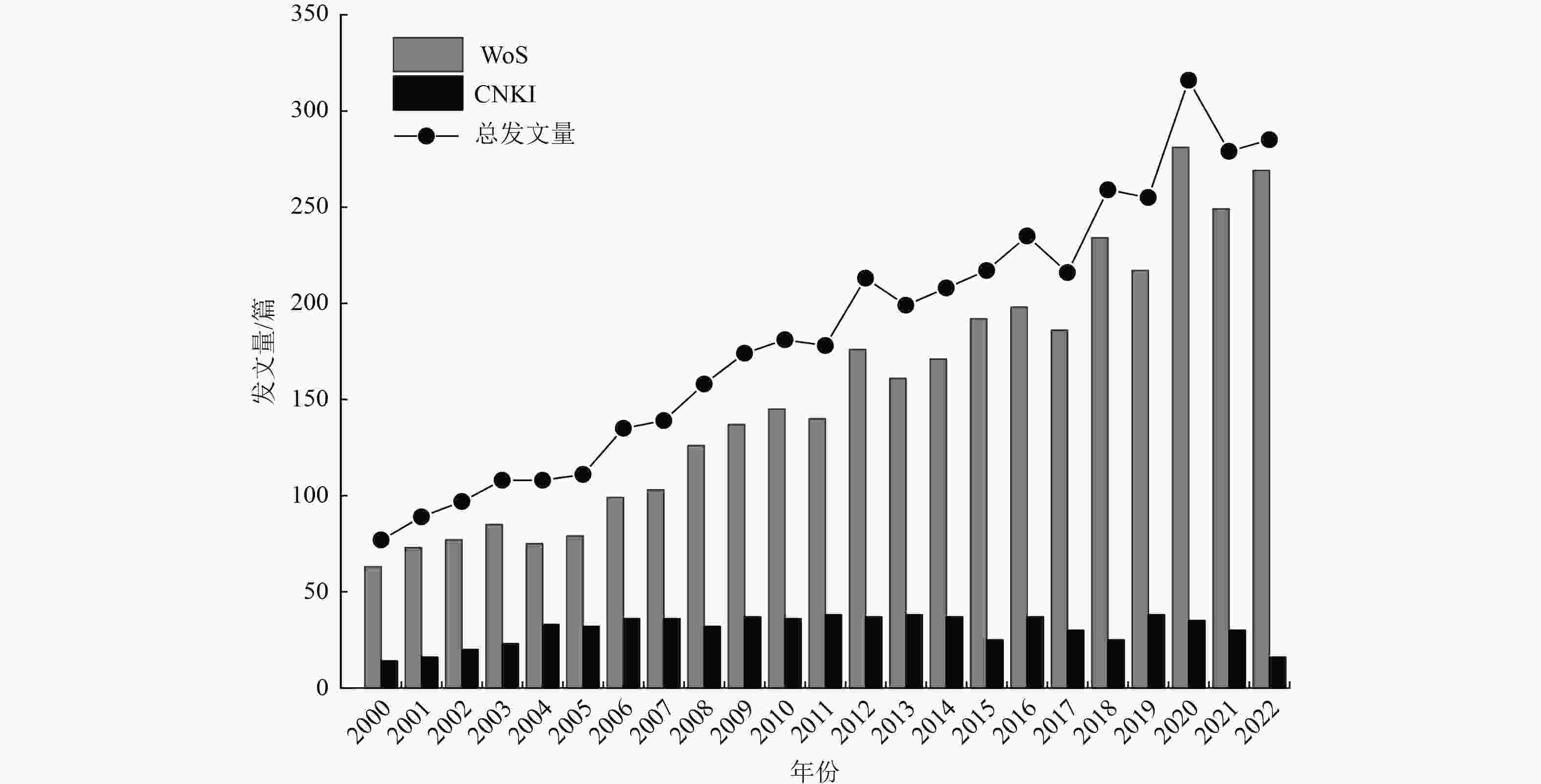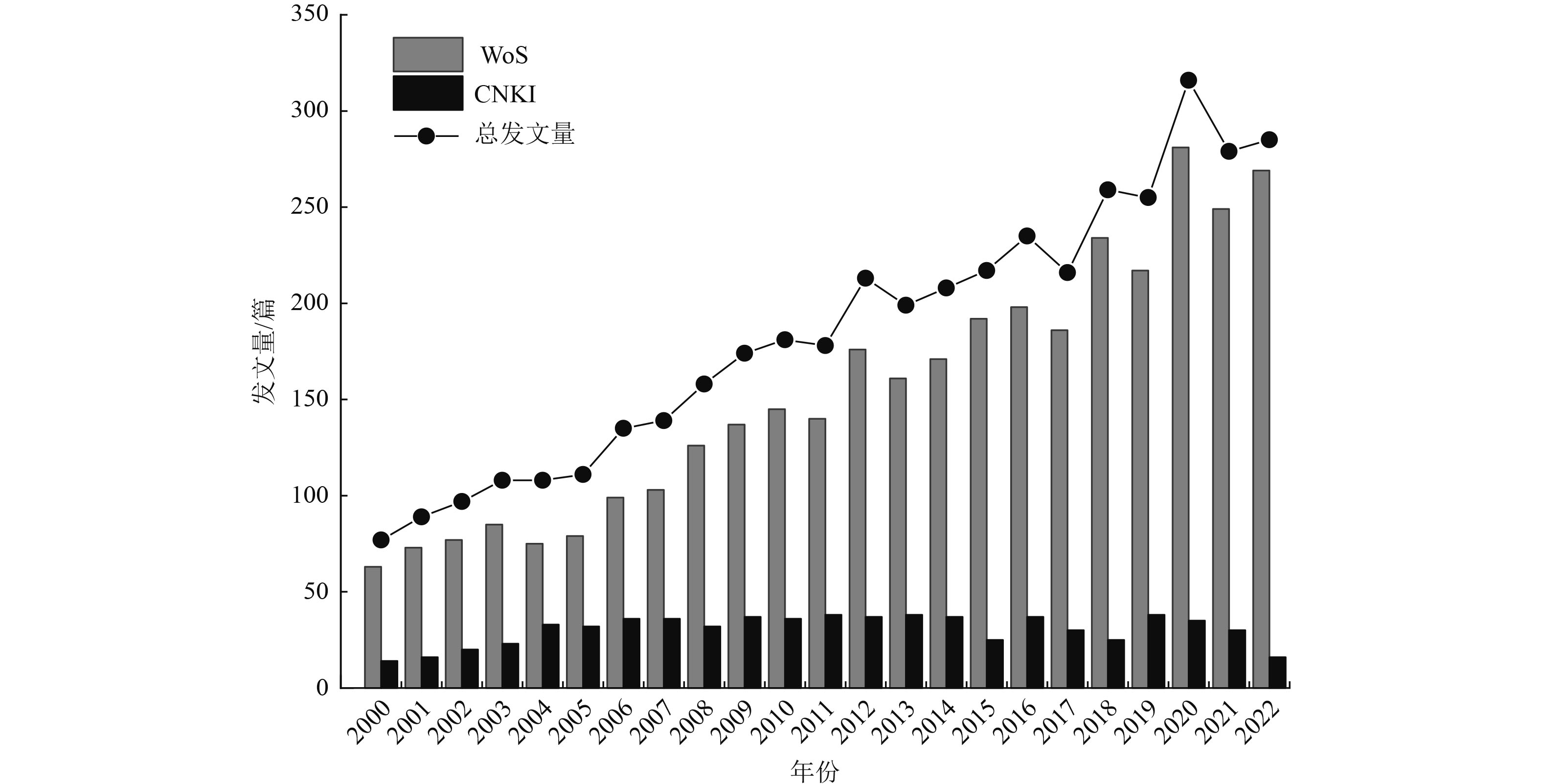Research hotspots and trend analysis of organophosphorus pesticides in the environmental field based on bibliometrics
-
摘要:
有机磷农药(OPPs)已逐渐取代有机氯农药成为广泛应用的农药之一,其大量使用对环境构成威胁,了解环境领域中OPPs的研究动态与趋势,可为相关领域的科研工作和环境管理提供借鉴。运用文献计量学方法,对2000—2022年中国知网(CNKI)核心数据库和Web of Science(WoS)核心数据库收录的环境领域OPPs的相关文献进行了分析,系统梳理了该领域OPPs的研究现状,阐述了OPPs研究的发展态势及热点前沿,同时提出了未来重点研究方向。结果表明:2000—2022年,国内外关于环境领域OPPs的研究论文共3 427篇,近10年来发文量呈显著上升趋势;环境领域OPPs的研究介质主要是水体和土壤,且对水体中OPPs的环境行为和特性探究更为深入;OPPs的检测手段以气相色谱法为主,毒死蜱〔O,O-二乙基-O-(3,5,6-三氯-2-吡啶基)硫代磷酸酯〕是OPPs研究中出现频率较高的目标污染物之一,且其在环境中的检出率较高;国内外关于OPPs在环境中的研究脉络基本相似,前期研究(2000—2010年)主要集中在环境中OPPs的萃取方法,中期研究(2011—2018年)主要集中在环境中OPPs的危害及对其的环境影响评价,近年来(2019—2022年)研究热点主要集中在OPPs的残留、环境检测以及高效去除等领域。未来建议加强OPPs降解产物的鉴定和环境毒性研究、OPPs复合暴露研究及环境修复研究,同时开发新型纳米材料和绿色农药替代方案等。
-
关键词:
- 有机磷农药(OPPs) /
- 文献计量学 /
- 风险评估 /
- 环境检测 /
- 环境毒性
Abstract:Organophosphorus pesticides (OPPs) have gradually replaced organochlorine pesticides (OCPs) as one of the most widely used pesticides, and their extensive use poses a threat to the environment. Understanding the dynamics and trends of OPPs research in the environmental field is beneficial for researchers and environmental managers in related fields. Using bibliometric methods, literature on OPPs in the field of environment sourced from the core databases of China Knowledge Network (CNKI) and Web of Science (WoS) from 2000 to 2022 were analyzed, and the current status of research, hotspots, and trends on OPPs in the field of environment were systematically clarified. The development trends and emerging frontiers in OPPs research were also described and key future research directions were proposed. The results indicated a significant increase in publications over the last decade, with a total of 3 427 papers published internationally and in China. OPPs in the environmental field were mainly studied in water and soil, and the environmental behavior and characteristics of OPPs in water were more deeply investigated. Gas chromatography was a primary detection method for OPPs. Chlorpyrifos was one of the target pollutants that have been studied more frequently in the research of OPPs, and its detection rate in the environment was high. The research on OPPs in the environment in China and abroad was basically similar, with early-stage research (2000-2010) mainly focusing on the investigation of the extraction methods of OPPs in the environment. In the mid-term research (2011-2018), the main focus was on the hazards of OPPs in the environment and the evaluation of their impact on the environment. In recent years (2019-2022), research hotspots have primarily focused on OPPs residue, environmental detection and efficient removal methods. In the future, it was recommended to intensify research efforts towards identifying OPPs degradation products, assessing their environmental toxicity, exploring compound exposure scenarios, investigating environmental remediation strategies, and advancing the development of new nanomaterials and environmentally friendly pesticide alternatives.
-
表 1 环境领域OPPs相关研究发文量排名前5的国家(WoS)
Table 1. Top 5 countries with OPPspublications (WoS) in the environmental field
排序 国家 发文量/篇 1 中国 1 058 2 伊朗 392 3 西班牙 298 4 美国 277 5 印度 259 表 2 环境领域OPPs相关研究发文量排名前5的机构
Table 2. Top 5 institutions with OPPs publications in the environmental field
排序 WoS CNKI 机构 发文量/篇 机构 发文量/篇 1 中国科学院 134 中国科学院 24 2 埃及科学研究技术院 99 四川大学 10 3 西班牙高等学术
研究委员会59 南京农业大学 7 4 大不里士大学 57 中山大学 5 5 中国农业大学 55 清华大学 5 表 3 环境领域OPPs相关研究发文量排名前5的期刊
Table 3. Top 5 journals with OPPs publications in the environmental field
WoS CNKI 期刊 发文量/
篇2022年影
响因子(IF)期刊 发文量/
篇Journal of Chromatography A 207 4.1 《理化检验
(化学分册)》12 Chemosphere 126 8.8 《中国环境监测》 9 Analytica Chimica Acta 115 6.2 《环境与健康杂志》 8 Talanta 98 6.1 《农业环境科学
学报》8 Journal of Agricultural and Food Chemistry 82 6.1 《农药学学报》 7 表 4 环境领域OPPs相关研究论文被引量排名前5的期刊
Table 4. Top 5 cited journals with OPPs publications in the environmental field
WoS CNKI 期刊 被引量/篇 2022年影响因子(IF) 期刊 被引量/篇 Journal of Chromatography A 1 297 4.1 《中国环境科学》 78 Chemosphere 1 103 8.8 《土壤通讯》 65 Environmental Science & Technology 955 11.4 《分析化学》 49 Journal of Agricultural and Food Chemistry 955 6.1 《环境化学》 39 Journal of Hazardous Materials 904 13.6 《色谱》 33 表 5 环境领域OPPs相关研究发文量排名前10的作者(WoS)
Table 5. Top 10 authors with OPPs publications in the environmental field (WoS)
作者 发文量/篇 论文总被引次数/次 Farajzadeh M A 52 1646 Mogaddam M R A 25 585 Albanis T A 21 1356 Wang J 14 616 Lambropoulou D A 13 796 Ibrahim W A W 13 425 Xu Z 12 439 Wang M 11 428 Srijaranai S 11 289 Wang C 11 566 表 6 WoS环境领域OPPs研究频次出现前10的关键词(不含中国)
Table 6. Top 10 keywords for frequency of OPPs in the environmental field (excluding China) in WoS
排序 关键词 出现频次/次 英文 中文 1 organophosphorus pesticides 有机磷农药 1 107 2 water 水 527 3 gas chromatography 气相色谱法 503 4 residues 残留 308 5 solid phase extraction 固相萃取 302 6 degradation 降解 291 7 mass spectrometry 质谱 219 8 toxicity 毒性 162 9 chlorpyrifos 毒死蜱 154 10 soil 土壤 145 表 7 WoS环境领域OPPs相关研究论文出现频次排名前10的关键词(仅中国)
Table 7. Top 10 keywords for frequency of OPPs in the environmental field (China only) in WoS
排序 关键词 出现频次/次 英文 中文 1 organophosphorus pesticides 有机磷农药 573 2 water 水体 265 3 gas chromatography 气相色谱法 231 4 residues 残留 157 5 extraction 萃取 127 6 mass spectrometry 质谱 119 7 degradation 降解 102 8 nanoparticles 纳米材料 88 9 soil 土壤 83 10 liquid chromatography 液相色谱法 66 表 8 2000—2022年WoS环境领域OPPs研究热点演化(不含中国)
Table 8. Development of research hotspots of OPPs in the environmental field (excluding China) in WoS from 2000 to 2022
关键词 突现强度 起始年 终止年 热点演化
(2000—2022年)英文 中文 water analysis 水分析 21.64 2000 2008 ●●●●●●●●●○○○○○○○
○○○○○○○pesticide 杀虫剂 15.97 2000 2008 ●●●●●●●●●○○○○○○○
○○○○○○○environment analysis 环境分析 11.28 2001 2005 ○●●●●●○○○○○○○○○○
○○○○○○○herbicides 除草剂 13.31 2000 2008 ●●●●●●●●●○○○○○○○
○○○○○○○samples 样本 11.13 2000 2005 ●●●●●●○○○○○○○○○○
○○○○○○○solid phase microextraction 固相微萃取 10.13 2010 2014 ○○○○○○○○○○●●●●●○
○○○○○○○liquid-liquid microextraction 液-液微萃取 11.69 2006 2017 ○○○○○○○●●●●●●●●●
●●○○○○○gas chromatography 气相色谱法 10.54 2008 2018 ○○○○○○○○○●●●●●●●
●●●○○○○chromatography mass spectrometry 色谱质谱法 8.87 2008 2017 ○○○○○○○○○●●●●●●●
●●○○○○○performance liquid chromatography 高效液相色谱法 7.55 2016 2018 ○○○○○○○○○○○○○○○○
●●●○○○○risk assessment 风险评估 18.18 2015 2021 ○○○○○○○○○○○○○○○●
●●●●●●○nanoparticles 纳米材料 11.91 2018 2022 ○○○○○○○○○○○○○○○○
○○●●●●●removal 去除 18.73 2018 2022 ○○○○○○○○○○○○○○○○
○○●●●●●waste water 废水 9.07 2018 2022 ○○○○○○○○○○○○○○○○
○○●●●●●adsorption 吸附 9.78 2021 2022 ○○○○○○○○○○○○○○○○
○○○○○●●表 9 2000—2022年WoS环境领域OPPs的研究热点演化(仅中国)
Table 9. Development of research hotspots of OPPs in the environmental field (China only) in WoS from 2000 to 2022
关键词 突现强度 起始年 终止年 热点演化
(2000—2022年)中文 英文 gas chromatography 气相色谱法 5.94 2003 2011 ○○○●●●●●●●●●○○○○
○○○○○○○samples 样本 5.43 2003 2009 ○○○●●●●●●●○○○○○○
○○○○○○○solid phase microextraction 固相萃取 11.44 2005 2014 ○○○○○●●●●●●●●●●○
○○○○○○○single drop microextraction 单滴微萃取 10.12 2007 2014 ○○○○○○○●●●●●●●●○
○○○○○○○chromatography mass spectrometry 色谱质谱法 8.70 2006 2014 ○○○○○○●●●●●●●●●○
○○○○○○○water samples 水样 6.63 2006 2014 ○○○○○○●●●●●●●●●○
○○○○○○○environment water samples 环境水样 5.49 2010 2019 ○○○○○○○○○○●●●●●●
●●●●○○○vegetables 蔬菜 5.89 2014 2018 ○○○○○○○○○○○○○○●●
●●●○○○○performance 表现 4.84 2016 2018 ○○○○○○○○○○○○○○○○
●●●○○○○removal 去除 11.47 2015 2022 ○○○○○○○○○○○○○○○●
●●●●●●●nanoparticles 纳米材料 6.69 2015 2022 ○○○○○○○○○○○○○○○●
●●●●●●●sensitive detection 感光检测 6.38 2020 2022 ○○○○○○○○○○○○○○○○
○○○○●●●risk assessment 风险评估 6.40 2015 2022 ○○○○○○○○○○○○○○○●
●●●●●●●assay 化验 7.36 2020 2022 ○○○○○○○○○○○○○○○○
○○○○●●●toxicity 毒性 6.68 2021 2022 ○○○○○○○○○○○○○○○○
○○○○○●● -
[1] 张春红, 白艳红, 陈杰瑢, 等. 有机磷农药废水降解方法研究新进展[J]. 水处理技术,2010,36(1):1-5.ZHANG C H, BAI Y H, CHEN J R, et al. The progress of study on degradation of organophosphorus pesticides in aqueous phase[J]. Technology of Water Treatment,2010,36(1):1-5. [2] SIDHU G K, SINGH S, KUMAR V, et al. Toxicity, monitoring and biodegradation of organophosphate pesticides: a review[J]. Critical Reviews in Environmental Science and Technology,2019,49(13):1135-1187. [3] MEHTA J, DHAKA R K, DILBAGHI N, et al. Recent advancements in adsorptive removal of organophosphate pesticides from aqueous phase using nanomaterials[J]. Journal of Nanostructure in Chemistry,2024,14(1):53-70. [4] POOMAGAL S, SUJATHA R, KUMAR P S, et al. A fuzzy cognitive map approach to predict the hazardous effects of malathion to environment (air, water and soil)[J]. Chemosphere,2021,263:127926. [5] 刘洁雪, 梁萧, 覃礼堂, 等. 漓江流域桂林市区段有机磷农药和磺胺类抗生素的复合污染及其生态风险[J]. 环境科学研究,2022,35(1):60-69.LIU J X, LIANG X, QIN L T, et al. Combined pollution and ecological risk of organophosphorus pesticides and sulfonamides antibiotics in Guilin section of Lijiang River Basin[J]. Research of Environmental Sciences,2022,35(1):60-69. [6] 郝雅琼, 黄泽春, 黄启飞, 等. 甘氨酸法生产草甘膦过程中母液产排节点与治理分析[J]. 环境科学研究,2023,36(6):1210-1217.HAO Y Q, HUANG Z C, HUANG Q F, et al. Analysis of nodes and treatment of mother liquor production and discharge in glyphosate production process by glycine method[J]. Research of Environmental Sciences,2023,36(6):1210-1217. [7] YAN D Y, JIANG X, XU S H, et al. Quantitative structure-toxicity relationship study of lethal concentration to tadpole (Bufo vulgaris formosus) for organophosphorous pesticides[J]. Chemosphere,2008,71(10):1809-1815. [8] OLISAH C, RUBIDGE G, HUMAN L R D, et al. Organophosphate pesticides in South African eutrophic estuaries: spatial distribution, seasonal variation, and ecological risk assessment[J]. Environmental Pollution,2022,306:119446. [9] WANG J W, TENG Y G, ZHAI Y Z, et al. Spatiotemporal distribution and risk assessment of organophosphorus pesticides in surface water and groundwater on the North China Plain, China[J]. Environmental Research, 2022, 204(Pt C): 112310. [10] AYIVI R D, OBARE S O, WEI J J. Molecularly imprinted polymers as chemosensors for organophosphate pesticide detection and environmental applications[J]. TrAC Trends in Analytical Chemistry,2023,167:117231. [11] 车霏霏, 陈俊伊, 王书航, 等. 南湖水系水-沉积物磷时空分布、影响因素及控制对策[J]. 环境工程技术学报,2020,10(6):928-935.CHE F F, CHEN J Y, WANG S H, et al. Spatio-temporal distribution, influencing factors and control strategies of phosphorus in water-sediment of Nanhu Lake water system[J]. Journal of Environmental Engineering Technology,2020,10(6):928-935. [12] ZHAO S M, XU W, ZHANG W L, et al. In-depth biochemical identification of a novel methyl parathion hydrolase from Azohydromonas australica and its high effectiveness in the degradation of various organophosphorus pesticides[J]. Bioresource Technology,2021,323:124641. [13] 卢艳敏, 张靖天, 张新波, 等. 巢湖沉积物中有机磷的生物可利用性研究[J]. 环境工程技术学报,2020,10(2):197-204. doi: 10.12153/j.issn.1674-991X.20190125LU Y M, ZHANG J T, ZHANG X B, et al. Bioavailability of organic phosphorus in Lake Chaohu sediments[J]. Journal of Environmental Engineering Technology,2020,10(2):197-204. doi: 10.12153/j.issn.1674-991X.20190125 [14] DROUT R J, KATO S, CHEN H Y, et al. Isothermal titration calorimetry to explore the parameter space of organophosphorus agrochemical adsorption in MOFs[J]. Journal of the American Chemical Society,2020,142(28):12357-12366. [15] BUSTOS N, CRUZ-ALCALDE A, IRIEL A, et al. Sunlight and UVC-254 irradiation induced photodegradation of organophosphorus pesticide dichlorvos in aqueous matrices[J]. Science of the Total Environment,2019,649:592-600. [16] LIU Y D, WU J K, CHENG N, et al. The overlooked role of UV185 induced high-energy excited states in the dephosphorization of organophosphorus pesticide by VUV/persulfate[J]. Chemosphere,2023,334:138993. doi: 10.1016/j.chemosphere.2023.138993 [17] FARAJZADEH M A, MOGADDAM M R A, AGHDAM S R, et al. Application of elevated temperature-dispersive liquid-liquid microextraction for determination of organophosphorus pesticides residues in aqueous samples followed by gas chromatography-flame ionization detection[J]. Food Chemistry,2016,212:198-204. doi: 10.1016/j.foodchem.2016.05.157 [18] MONTUORI P, AURINO S, GARZONIO F, et al. Estimates of Tiber River organophosphate pesticide loads to the Tyrrhenian Sea and ecological risk[J]. Science of the Total Environment,2016,559:218-231. [19] YANG Q T, ZHAO S X, LI H Y, et al. Acidic pH and thiol-driven homogeneous cathodic electrochemiluminescence strategy for determining the residue of organophosphorus pesticide in Chinese cabbage[J]. Food Chemistry,2022,393:133349. [20] RAJ A, KUMAR A. Recent advances in assessment methods and mechanism of microbe-mediated chlorpyrifos remediation[J]. Environmental Research, 2022, 214(Pt 4): 114011. [21] WAN Y Q, LIU J H, PI F W, et al. Advances on removal of organophosphorus pesticides with electrochemical technology[J]. Critical Reviews in Food Science and Nutrition,2023,63(27):8850-8867. [22] SUD D, KAUR P. Heterogeneous photocatalytic degradation of selected organophosphate pesticides: a review[J]. Critical Reviews in Environmental Science and Technology,2012,42(22):2365-2407. [23] HARLEY K G, ENGEL S M, VEDAR M G, et al. Prenatal exposure to organophosphorous pesticides and fetal growth: pooled results from four longitudinal birth cohort studies[J]. Environmental Health Perspectives,2016,124(7):1084-1092. [24] WEE S Y, ARIS A Z. Ecological risk estimation of organophosphorus pesticides in riverine ecosystems[J]. Chemosphere,2017,188:575-581. [25] SPARLING D W, FELLERS G. Comparative toxicity of chlorpyrifos, diazinon, malathion and their oxon derivatives to larval Rana boylii[J]. Environmental Pollution,2007,147(3):535-539. doi: 10.1016/j.envpol.2006.10.036 [26] MAGGIO S A, JENKINS J J. Multi- and trans-generational effects on Daphnia magna of chlorpyrifos exposures[J]. Environmental Toxicology and Chemistry,2022,41(4):1054-1065. doi: 10.1002/etc.5283 [27] PATHANIA D, SHARMA A, KUMAR S, et al. Bio-synthesized Cu-ZnO hetro-nanostructure for catalytic degradation of organophosphate chlorpyrifos under solar illumination[J]. Chemosphere,2021,277:130315. [28] ECHEVERRI-JARAMILLO G, JARAMILLO-COLORADO B, JUNCA H, et al. Towards the development of microbial ecotoxicology testing using chlorpyrifos contaminated sediments and marine yeast isolates as a model[J]. Microorganisms,2022,10(10):2019. [29] FANG X Y, GAN L, WANG L J, et al. Enhanced degradation of bisphenol A by mixed ZIF derived CoZn oxide encapsulated N-doped carbon via peroxymonosulfate activation: the importance of N doping amount[J]. Journal of Hazardous Materials,2021,419:126363. [30] PEHKONEN S O, ZHANG Q. The degradation of organophosphorus pesticides in natural waters: a critical review[J]. Critical Reviews in Environmental Science and Technology,2002,32(1):17-72. doi: 10.1080/10643380290813444 [31] SHABBIR M, SINGH M, MAITI S, et al. Removal enactment of organo-phosphorous pesticide using bacteria isolated from domestic sewage[J]. Bioresource Technology,2018,263:280-288. doi: 10.1016/j.biortech.2018.04.122 [32] MALAKOOTIAN M, SHAHESMAEILI A, FARAJI M, et al. Advanced oxidation processes for the removal of organophosphorus pesticides in aqueous matrices: a systematic review and meta-analysis[J]. Process Safety and Environmental Protection,2020,134:292-307. doi: 10.1016/j.psep.2019.12.004 [33] KERMANI M, DOWLATI M, GHOLAMI M, et al. A global systematic review, meta-analysis and health risk assessment on the quantity of Malathion, Diazinon and Chlorpyrifos in Vegetables[J]. Chemosphere,2021,270:129382. doi: 10.1016/j.chemosphere.2020.129382 [34] ALFONSO L F, GERMÁN G V, MARÍA del CARMEN P C, et al. Adsorption of organophosphorus pesticides in tropical soils: the case of Karst landscape of northwestern Yucatan[J]. Chemosphere,2017,166:292-299. [35] CHEN Z F, ZHANG Y, YANG Y Q, et al. Hierarchical nitrogen-doped holey graphene as sensitive electrochemical sensor for methyl parathion detection[J]. Sensors and Actuators B:Chemical,2021,336:129721. doi: 10.1016/j.snb.2021.129721 [36] RANA S, KAUR R, JAIN R, et al. Ionic liquid assisted growth of poly(3,4-ethylenedioxythiophene)/reduced graphene oxide based electrode: an improved electro-catalytic performance for the detection of organophosphorus pesticides in beverages[J]. Arabian Journal of Chemistry,2019,12(7):1121-1133. doi: 10.1016/j.arabjc.2018.08.008 [37] CAO Y, WANG L N, SHEN C, et al. An electrochemical sensor on the hierarchically porous Cu-BTC MOF platform for glyphosate determination[J]. Sensors and Actuators B: Chemical,2019,283:487-494. doi: 10.1016/j.snb.2018.12.064 [38] TRIASSI M, NARDONE A, GIOVINETTI M C, et al. Ecological risk and estimates of organophosphate pesticides loads into the Central Mediterranean Sea from Volturno River, the River of the "Land of Fires" area, southern Italy[J]. Science of the Total Environment,2019,678:741-754. doi: 10.1016/j.scitotenv.2019.04.202 [39] SUMON K A, RASHID H, PEETERS E T H M, et al. Environmental monitoring and risk assessment of organophosphate pesticides in aquatic ecosystems of north-west Bangladesh[J]. Chemosphere,2018,206:92-100. doi: 10.1016/j.chemosphere.2018.04.167 [40] CASTORINA R, BRADMAN A, McKONE T E, et al. Cumulative organophosphate pesticide exposure and risk assessment among pregnant women living in an agricultural community: a case study from the CHAMACOS cohort[J]. Environmental Health Perspectives,2003,111(13):1640-1648. doi: 10.1289/ehp.5887 [41] HUANG X, CUI H W, DUAN W Y. Ecotoxicity of chlorpyrifos to aquatic organisms: a review[J]. Ecotoxicology and Environmental Safety,2020,200:110731. doi: 10.1016/j.ecoenv.2020.110731 [42] YANG Q T, LI Q, LI H Y, et al. pH-response quantum dots with orange-red emission for monitoring the residue, distribution, and variation of an organophosphorus pesticide in an agricultural crop[J]. Journal of Agricultural and Food Chemistry,2021,69(9):2689-2696. doi: 10.1021/acs.jafc.0c08212 [43] VELOO K V, IBRAHIM N A S. Analytical extraction methods and sorbents' development for simultaneous determination of organophosphorus pesticides' residues in food and water samples: a review[J]. Molecules,2021,26(18):5495. doi: 10.3390/molecules26185495 [44] CHEN Q, SUN Y D, LIU S J, et al. Colorimetric and fluorescent sensors for detection of nerve agents and organophosphorus pesticides[J]. Sensors and Actuators B: Chemical,2021,344:130278. doi: 10.1016/j.snb.2021.130278 [45] ZHENG W S, SUN Y, GU Y P. Assembly of UiO-66 onto Co-doped Fe3O4 nanoparticles to activate peroxymonosulfate for efficient degradation of fenitrothion and simultaneous in situ adsorption of released phosphate[J]. Journal of Hazardous Materials,2022,436:129058. doi: 10.1016/j.jhazmat.2022.129058 [46] LI W, WU R Q, DUAN J M, et al. Impact of prechlorination on organophosphorus pesticides during drinking water treatment: removal and transformation to toxic oxon byproducts[J]. Water Research,2016,105:1-10. doi: 10.1016/j.watres.2016.08.052 [47] YAN X, SONG Y, ZHU C Z, et al. MnO2 nanosheet-carbon dots sensing platform for sensitive detection of organophosphorus pesticides[J]. Analytical Chemistry,2018,90(4):2618-2624. doi: 10.1021/acs.analchem.7b04193 [48] CAI Y, QIU Z Y, LIN X B, et al. Self-assembled nanomaterials based on aggregation-induced emission of AuNCs: fluorescence and colorimetric dual-mode biosensing of organophosphorus pesticides[J]. Sensors and Actuators B: Chemical,2020,321:128481. doi: 10.1016/j.snb.2020.128481 [49] WANG X L, QIAO X G, MA Y, et al. Simultaneous determination of nine trace organophosphorous pesticide residues in fruit samples using molecularly imprinted matrix solid-phase dispersion followed by gas chromatography[J]. Journal of Agricultural and Food Chemistry,2013,61(16):3821-3827. doi: 10.1021/jf400269q [50] MA Z H, GAO Y J, CHU F J, et al. Tip-assisted ambient electric arc ionization mass spectrometry for rapid detection of trace organophosphorus pesticides in strawberry[J]. Chinese Chemical Letters,2022,33(9):4411-4414. [51] BHANTI M, TANEJA A. Contamination of vegetables of different seasons with organophosphorous pesticides and related health risk assessment in northern India[J]. Chemosphere,2007,69(1):63-68. doi: 10.1016/j.chemosphere.2007.04.071 [52] HUEN K R, BRADMAN A, HARLEY K, et al. Organophosphate pesticide levels in blood and urine of women and newborns living in an agricultural community[J]. Environmental Research,2012,117:8-16. [53] BIDARI A, GANJALI M R, NOROUZI P, et al. Sample preparation method for the analysis of some organophosphorus pesticides residues in tomato by ultrasound-assisted solvent extraction followed by dispersive liquid-liquid microextraction[J]. Food Chemistry,2011,126(4):1840-1844. doi: 10.1016/j.foodchem.2010.11.142 [54] DEHGHANI M H, NIASAR Z S, MEHRNIA M R, et al. Optimizing the removal of organophosphorus pesticide malathion from water using multi-walled carbon nanotubes[J]. Chemical Engineering Journal,2017,310:22-32. doi: 10.1016/j.cej.2016.10.057 [55] VASSEGHIAN Y, ALMOMANI F, LE V T, et al. Decontamination of toxic Malathion pesticide in aqueous solutions by Fenton-based processes: degradation pathway, toxicity assessment and health risk assessment[J]. Journal of Hazardous Materials, 2022, 423(Pt A): 127016. ◇ -





 下载:
下载:




